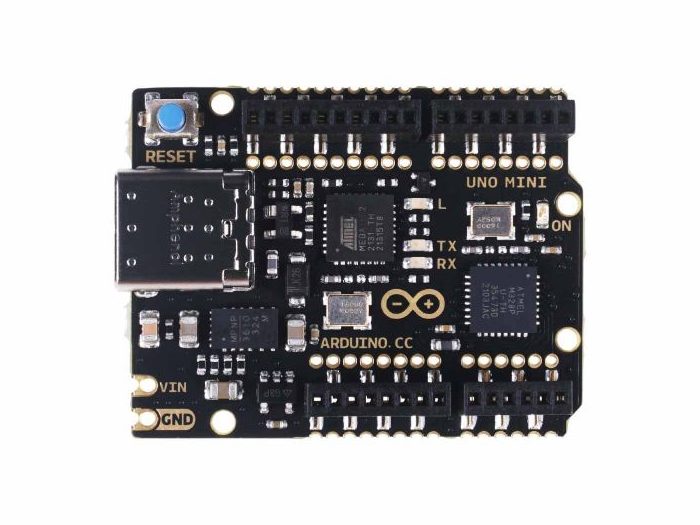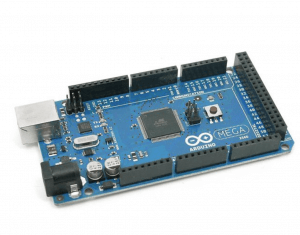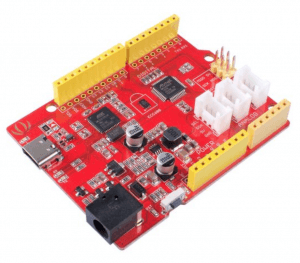Arduino Boards Selection Guide
Arduino is an open-source platform that includes both hardware and software. The hardware of Arduino contains many programmable circuit boards as a microcontroller for connecting sensors or other modules to build up a project. In terms of Arduino products, we provide many Arduino boards such as Arduino Uno, Arduino Mega, etc. Besides, there are also many extend boards based on the Arduino platform such as Seeeduino Boards. There are many Arduino boards in the market. How to choose the right Arduino board for your next project?

In today’s guide, we listed specifications including processor, operating voltage, input voltage, clock speed, digital I/O, PWM, analog inputs, UART, Grove connectors, flash memory and USB connectors for 7 Arduino official boards, 13 Seeeduino boards and 5 MCUs. Hope this guide will help you quickly compare different Arduino boards and we will keep updating the guide for sure once we get new products released!
In order to be compatible with our Grove system, we have also released many shields for Arduino or Seeeduino which includes Grove interface to connect the boards and Grove modules easily without jump wires.
Arduino Boards Selection Guide
| Processor | Operating Voltage | Clock Speed | Digital I/O | PWM | Analog Inputs | UART | Grove | Flash(KB) | USB | |
| Arduino Uno | ATmgea328 | 5V | 16 MHZ | 14 | 6 | 6 | 1 | 0 | 32 | Micro USB |
| Arduino UNO Mini Limited Edition | ATmega328P | 5V | 16MHZ | 14 | 6 | 6 | 1 | 32 | Type-C | |
| Arduino Mega 2560 R3 | ATmega2560 | 5V | 16 MHZ | 54 | 15 | 16 | 4 | 0 | 256 | Type-B USB |
| Arduino Nano | ATmgea328 | 5V | 16 MHZ | 14 | 6 | 8 | 1 | 0 | 32 | Mini USB |
| Arduino Micro | ATmega32u4 | 5V | 16 MHZ | 20 | 7 | 12 | 2 | 0 | 32 | Micro USB |
| Arduino YUN | ATmega32u4 | 5V | 16 MHZ | 20 | 7 | 12 | 2 | 0 | 32 | Micro USB |
| Arduino MKR1000 wifi | ATSAMW25 SoC | 5V | 48 MHZ | 8 | 12 | 7 | 1 | 0 | 256 | Micro USB |
| Seeeduino Mega | ATmega2560 | 5V/3.3V | 16MHz | 70 | 14 | 16 | 4 | 0 | 256 | Micro USB |
| Seeeduino Lite | ATmega32u4 | 5V/3.3V | 16MHz | 20 | 7 | 12 | 1 | 2 | 32 | Micro USB |
| Seeeduino GPRS | ATmega32u4 | 5V/3.3V | 16MHz | 20 | 7 | 12 | 1 | 0 | 32 | Micro USB |
| Seeeduino Cloud | ATmega32u4 | 5V/3.3V | 16MHz | 20 | 7 | 12 | 1 | 2 | 32 | Micro USB |
| Seeeduino V4.2 | Atmega328 | 5V/3.3V | 16MHz | 14 | 6 | 6 | 1 | 3 | 32 | Micro USB |
| Seeeduino Stalker V3.1 | Atmega328P | 5V/3.3V | 8MHz | 14 | 0 | 6 | 1 | 2 | 32 | Mini USB |
| Seeeduino LoRaWAN | ATSAMD21G18 | 5V/3.3V | 48MHz | 20 | 20 | 6 | 2 | 4 | 256 | Micro USB |
| Seeeduino LoRaWAN W/GPS | ATSAMD21G18 | 3.3V | 48MHz | 20 | 20 | 6 | 1 | 4 | 256 | Micro USB |
| Seeeduino Lotus V1.1 | Atmega328P | 5V | 16MHz | 14 | 6 | 7 (0-5, ADC) | 2 | 12 | 32 | Micro USB |
| Seeeduino Lotus Cortex-M0+ | SAMD21 | 3.3V | 48MHz | 14 | 10 | 6 | 1 | 12 | 256 | Micro USB |
| Seeeduino Cortex-M0+ | SAMD21 | 5V | 48MHz | 14 | 10 | 6 | 1 | 3 | 256 | Type-C |
| Seeeduino Nano | Atmega328P | 5V | 16MHz | 14 | 6 | 8 | 1 | 1 | 32 | Type-C |
| Seeeduino Crypto | ATmega4809 | 5V | 16MHz | 14 | 5 | 6 | 1 | 3 | 48 | Type-C |
| Seeeduino XIAO | SAMD21G18 | 3.3V | 48MHz | 11 | 10 | 11 | 1 | 0 | 256 | Type-C |
| NodeMCU v2 | 32-bit RISC Tensilica Xtensa LX106 | 3.3V | 80MHz | 16 | 1 | 1 | 2 | 0 | 4 | Micro USB |
| TI MSP430 USB LaunchPad | MSP430F5529 | 3V | 25MHz | 8 | 14 | 16 | 2 | 0 | 128 | Micro USB |
| Particle Photon | STM32F205 | 5V | 120MHz | 18 | 9 | 10 | 1 | 0 | 1MB | Micro USB |
| GeeekNET ESP32 Development Board | Xtensa® Single-/Dual-core 32-bit LX6 microprocessor | 3.3V | 160MHz | 39 | 16 | 2 | 3 | 0 | 4MB | Mini USB |
| Wio Terminal | ATSAMD51P19 | 5V | 120MHz | via Grove | via Grove | via Grove | 1 | 2 | 4 | Type- C |
Let’s also take a look at each board!
Arduino Uno R3

The Arduino Uno Rev 3 is a microcontroller board based on the ATmega328. Uno is the first in a series of USB-based Arduino boards.
| Processor | Operating Voltage | Clock Speed | Digital I/O | PWM | Analog Inputs | UART | Grove | Flash(KB) | USB |
|---|---|---|---|---|---|---|---|---|---|
| ATmgea328 | 5V | 16 MHZ | 14 | 6 | 6 | 1 | 0 | 32 | Micro USB |
Arduino UNO Mini Limited Edition
The Arduino UNO Mini Limited Edition is a black & gold and mini version of the classic Arduino UNO that there is a unique number and hand-signed letter on each board.

| Processor | Operating Voltage | Clock Speed | Digital I/O | PWM | Analog In | UART | Grove | Flash(KB) | USB |
|---|---|---|---|---|---|---|---|---|---|
| Arduino UNO Mini LE | 5v | 16 MHZ | 14 | 6 | 6 | 1 | 0 | 32 | Type-C USB |
Arduino Mega 2560 R3
The Arduino Mega 2560 Rev3 is a microcontroller board based on the ATmega2560. This product is retired, please consider our Seeeduino Mega as your alternative choice, which is derived from Arduino Mega, Seeeduino Mega combines the advantage of both Arduino Mega and Seeeduino while the price is lower compare to Arduino Mega 2560.

| Processor | Operating Voltage | Clock Speed | Digital I/O | PWM | Analog In | UART | Grove | Flash(KB) | USB |
|---|---|---|---|---|---|---|---|---|---|
| ATmega2560 | 5V | 16 MHZ | 54 | 15 | 16 | 4 | 0 | 256 | Type-B USB |
Arduino Nano
The Arduino Nano is a small, complete, and breadboard-friendly board based on the ATmega328 (Arduino Nano 3.0).

| Processor | Operating Voltage | Clock Speed | Digital I/O | PWM | Analog Inputs | UART | Grove | Flash(KB) | USB |
|---|---|---|---|---|---|---|---|---|---|
| ATmega328 | 5V | 16 MHZ | 14 | 6 | 8 | 1 | 0 | 32 | Mini USB |
Arduino Micro
Arduino Micro is similar to the Arduino Leonardo in that the ATmega32U4 has built-in USB communication, eliminating the need for a secondary processor. This allows the Micro to appear to a connected computer as a mouse and keyboard

| Processor | Operating Voltage | Clock Speed | Digital I/O | PWM | Analog Inputs | UART | Grove | Flash(KB) | USB |
|---|---|---|---|---|---|---|---|---|---|
| ATmega32u4 | 5V | 16 MHZ | 20 | 7 | 12 | 2 | 0 | 32 | Micro USB |
Arduino YUN
Arduino YÚN is the first member of a new groundbreaking line of wifi products combining the power Linux with ease of use of Arduino. This product is discontinued, please consider our Seeeduino Cloud – Arduino Yun compatible OpenWRT controller as your alternative choice.

| Processor | Operating Voltage | Clock Speed | Digital I/O | PWM | Analog Inputs | UART | Grove | Flash(KB) | USB |
|---|---|---|---|---|---|---|---|---|---|
| ATmega32u4 | 5V | 16 MHZ | 20 | 7 | 12 | 2 | 0 | 32 | Micro USB |
Arduino MKR1000 wifi
Arduino MKR1000 is a powerful board that combines the functionality of the Zero and the Wi-Fi Shield. It is the ideal solution for makers wanting to design IoT projects with minimal previous experience in networking.

| Processor | Operating Voltage | Clock Speed | Digital I/O | PWM | Analog Inputs | UART | Grove | Flash(KB) | USB |
|---|---|---|---|---|---|---|---|---|---|
| ATSAMW25 SoC | 5V | 48 MHZ | 8 | 12 | 7 | 1 | 0 | 256 | Micro USB |
Seeeduino XIAO
Seeeduino XIAO is the smallest Arduino compatible board in Seeeduino Family, as small as a thumb(20×17.5mm) for wearable devices and small projects. It is an Arduino microcontroller that is embedded with the SAMD21 microchip. The interfaces of Seeeduino XIAO is rich enough in such a tiny Dev. Board as well.

Seeeduino Mega(ATmega2560)
Seeeduino Mega is built around ATmega2560 at 16MHz clock speed and with massive GPIOs: 70 digital I/Os, 16 Analog input and 4 UART, etc.
Small form factor, 30% smaller than Arduino Mega 3.3V and 5V dual-mode It can be powered through a battery or through an AC to DC adaptor.

Seeeduino Lite
Seeeduino Lite shares many similarities with Arduino Leonardo. It is a microcontroller board based on the Atmega32U4 chip. It contains everything needed to support the microcontroller; simply connect it to a computer with a USB cable or power it with an AC-to-DC adapter to get started.

Seeeduino GPRS
You can connect Seeeduino GPRS to the internet through GPRS wireless network with it. Making/answering voice calls and sending/receiving SMS messages are also supported. Meanwhile, Seeeduino GPRS supports FM radio function and Bluetooth communication.

Seeeduino Cloud
Seeeduino Cloud is a microcontroller board based on the Dragino WiFi IoT module HE and ATmega32u4. Seeeduino Cloud is also an Arduino compatible board, 100% compatible with Grove, shield, and IDEs(Arduino IDE 1.5.3 and later).

Seeeduino V4.2
Seeeduino V4.2 is an Arduino-compatible board, which is based on ATmega328P MCU, Arduino UNO bootloader, and with an ATMEGA16U2 as a UART-to-USB converter. The three on-board Grove interface can make your board connect to over 300 Grove modules.

Seeeduino Stalker V3.1
Seeeduino Stalker V3.1 is Arduino UNO compatible with Arduino Fio bootloader. There is also onboard Lipo battery manager IC, Solar charge input(jst2.0 connector) and Real-Time Clock chip DS1337S.

Seeeduino LoRaWAN
Seeeduino LoRaWAN is an Arduino board with LoRaWan protocol embedded, through which you can get started quickly to experience LoRa’s advantage in the field of IoT. There is also another version in the below with GPS.

Seeeduino LoRaWAN W/GPS

Seeeduino Lotus V1.1
Seeeduino Lotus V1.1 is based on ATMEGA328P-MU, a high performance, low power 8-Bit AVR Microcontroller. It is Arduino compatible and with rich peripherals.

Seeeduino Lotus Cortex-M0+
Seeeduino Lotus Cortex-M0+ is a SAMD21 Microcontroller development board. The Atmel® | SMART™ SAM D21 is a series of low-power microcontrollers using the 32-bit ARM® Cortex®-M0+ processor with 256KB Flash and 32KB of SRAM.

Seeeduino Cortex-M0+
The Seeeduino Cortex-M0+ features an Atmel SAMD21 MCU which is based on a 32-bit ARM® Cortex®-M0+ processor. With the help of this powerful core, SAMD21 is much more powerful than AVR and can achieve many functions and more complex calculations that cannot be implemented on AVR chips.

Seeeduino Nano
The Seeeduino Nano is a compact board similar to the Seeeduino V4.2/Arduino UNO, and it is fully compatible with Arduino Nano on pinout and sizes.

Seeeduino Crypto
Seeeduino Crypto is based on high-performance ATmega4809 and featured with Microchip ECC608 crypto chip. With the help of the ECC608 crypto chip, you can experience encrypted communication, such as I2C encryption.

NodeMCU v2
The NodeMCY v2 is based on the ESP8266, a low-cost WiFi module on-board and integrates GPIO, PWM, IIC, 1-Wire and ADC all in one board. On top of that, it’s really affordable as well, perfect if you’re looking for an easy, simple to use MCU for IoT application.

| Processor | Operating Voltage | Clock Speed | Digital I/O | PWM | Analog Inputs | UART | Grove | Flash (KB) | USB |
| 32-bit RISC Tensilica Xtensa LX106 | 3.3V | 80MHz | 16 | 1 | 1 | 2 | 0 | 4 | Micro USB |
TI MSP430 USB LaunchPad
The Texas Instruments MSP430 has an onboard emulation for programming and debugging, as well as buttons and LEDs for simple user interface. Moreover, it is a low power MCU that also comes with one USB connection for emulator and target via the use of an onboard USB hub.

| Processor | Operating Voltage | Clock Speed | Digital I/O | PWM | Analog Inputs | UART | Grove | Flash (KB) | USB |
| MSP430F5529 | 3V | 25MHz | 8 | 14 | 16 | 2 | 0 | 128 | Micro USB |
Particle Photon
Particle Photon has combined a powerful ARM Cortex M3 microcontroller with a Broadcom Wi-Fi chip in a tiny thumbnail-size module called the P0 (P-Zero). It’s tiny and portable size makes it perfect for smaller projects as well.

| Processor | Operating Voltage | Clock Speed | Digital I/O | PWM | Analog Inputs | UART | Grove | Flash (KB) | USB |
| STM32F205 | 5V | 120MHz | 16 | 9 | 10 | 1 | 0 | 1MB | Micro USB |
GeeekNET ESP32 Development Board
The ESP32 is based on the WROOM32 module, perfect for IoT projects, it is also the successor of the ESP8266 processor. The ESP32 would provide a larger number of GPIOs, including analogue inputs and outputs, and a more powerful and faster processor. It is Dependable and makes it a great option for IoT project.

| Processor | Operating Voltage | Clock Speed | Digital I/O | PWM | Analog Inputs | UART | Grove | Flash (KB) | USB |
| Xtensa® Single-/Dual-core 32-bit LX6 microprocessor | 3.3V | 160MHz | 39 | 16 | 2 | 3 | 0 | 4MB | Mini USB |
Wio Terminal
The Wio Terminal is an ATSAMD51-based microcontroller with wireless connectivity supported by Realtek RTL8720DN. Also, it is a complete system equipped with Screen + Development Board + Input/Output Interface + Enclosure, making it an efficient and Product-Ready Product.

| Processor | Operating Voltage | Clock Speed | Digital I/O | PWM | Analog Inputs | UART | Grove | Flash (KB) | USB |
| ATSAMD51P19 | 5V | 120MHz | via Grove | via Grove | via Grove | 1 | 02 | 4 | Type- C |
Summary
And that’s all on our Arduino Boards Selection Guide! Hope that this guide has helped you to compare the different Arduino boards and find the compatible for your next project!

